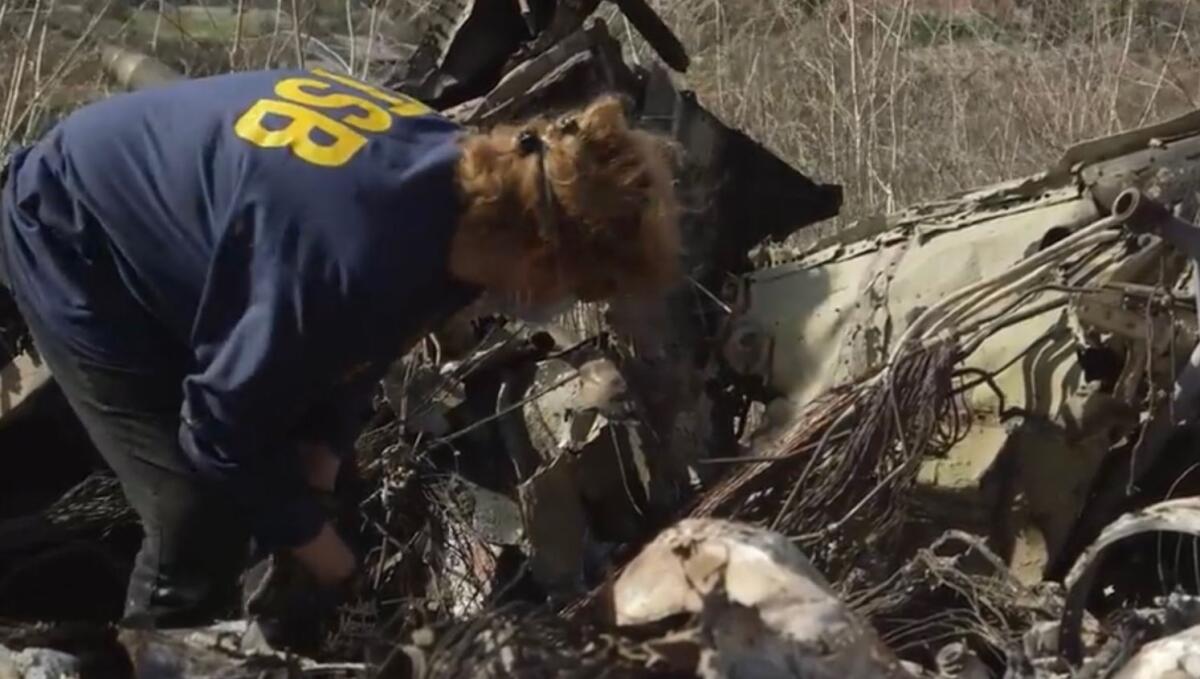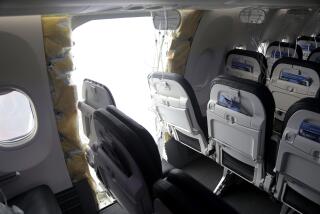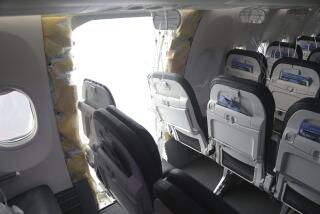Kobe Bryant crash renews battle over rejected safety regulations

After the deaths of Kobe Bryant and eight others in a helicopter crash on a Calabasas hillside last week, a National Transportation Safety Board member said federal aviation regulators had previously rejected an NTSB recommendation to require a terrain warning system, a safety feature that might have saved their lives.
It was hardly the first time the NTSB had publicly questioned the Federal Aviation Administration’s decisions.
For the record:
10:09 a.m. Feb. 2, 2020An earlier version of this article cited the Federal Aviation Administration’s rate of fatal helicopter accidents per 100,000 flights. It should have stated it per 100,000 flight hours.
For decades, the two federal agencies have clashed on a range of issues, including smoke detectors in airline cargo holds and crashworthy fuel tanks on light helicopters. Although both agencies tout their close working relationship, neither disputes that it can be contentious.
The NTSB, which investigates aviation accidents, has made thousands of safety recommendations over the years but has no power to enforce them. The FAA, which has sole authority to set the rules, has accepted about 75% of them, according to the FAA’s most recent tally of closed cases in late 2018.
“The two agencies share a common goal: promoting aviation safety and preventing aircraft accidents, although they occasionally have different views on the most appropriate course of action,” the FAA said in a statement to the Los Angeles Times.
Fatal accidents that have occurred on the heels of rejected or long-delayed safety recommendations have sometimes served as major friction points in the complicated relationship between the agencies.
“When the FAA says, ‘Thank for your interest in aviation safety’ and ‘We’ll study your recommendation,’ and then they study it and study it and study it, and then another accident happens. … If you’re the NTSB, it’s pretty frustrating if it’s something you’ve been talking about for 10 years,” said Greg Feith, a former NTSB senior accident investigator.
Criticism of the FAA from various quarters goes back to the Eisenhower administration, when Congress created the agency in 1958 with a dual and often conflicting mandate to ensure the safety of civil air travel and to promote the aviation industry.
For decades, the FAA battled the perception that it put commerce before safety, especially when rejecting corrective actions as too expensive for airlines and other industry players. The FAA is required by federal law to base safety decisions on risk assessment and cost-benefit analysis, a major difference between it and the NTSB.
One of the FAA’s most controversial and ill-fated decisions came in 1993, when it rejected an NTSB recommendation to require smoke detectors and fire-suppression systems in airplane cargo holds that are inaccessible to the crew during flight.
The requirement would have cost the airline industry more than $350 million and “would not have provided a significant degree of protection” to those aboard the planes, the FAA said at the time — and would soon regret.
In 1996, oxygen canisters stowed in the hold of a ValuJet DC-9 caught fire and caused it to crash in the Florida Everglades, 10 minutes after takeoff from Miami International Airport.
“They decided not to mandate it, and then we lost a ValuJet,” Feith, who investigated the Flight 592 disaster, said in an interview. “We lost 110 people.”
The NTSB’s final accident report cited the FAA’s failure to require smoke detectors and fire suppression systems as one of the main causes of the crash.
Under public pressure to reform the FAA, Congress amended the Federal Aviation Act in October 1996 to delete references to the agency’s “promoting” of the aviation industry, while underscoring and expanding the safety aspects of its mission.
The FAA relented on its earlier opposition and adopted the NTSB recommendations on smoke detectors and fire suppression systems in cargo holds.
The NTSB and the FAA also have clashed over the years on several issues involving Robinson Helicopters, manufactured by the family-owned company in Torrance.
The agencies have been at odds over safety concerns on rotor blades and in-flight vibrations, as well as more-crashworthy fuel tanks for the Robinson R44, the world’s most popular civilian helicopter.
Two months after the four-seat model was introduced in 1993, three men died when the all-aluminum fuel tank on an R44 ruptured and caught fire in a crash on the runway at El Monte Airport, just after takeoff. The three were the first of dozens of people killed or seriously injured when R44s caught fire in otherwise survivable accidents.
It would take Robinson 16 years to begin fitting new R44s in 2009 with more-crashworthy tanks lined with flexible bladders. In 2010, the company recommended the bladders as a retrofit for existing R44s, and offered them as a kit for $6,800.
But many owners did not make voluntary retrofits, and fatal post-crash fires continued to occur. In 2012, an Orange County attorney and private pilot, Jim Bechler, died when his R44’s tank breached and caught fire in a low-impact accident at the Corona Airport.
By 2013, Australian aviation authorities had become so alarmed by fatal R44 fires that they grounded them until their tanks were reinforced with flexible bladders. Within weeks, officials in New Zealand and South Africa issued similar orders. The European Aviation Safety Agency, with 32 member countries, also took steps to speed up retrofits.
In 2014, the NTSB expressed its own concerns about the vulnerability of R44 tanks and asked the FAA to also make the retrofits mandatory in the United States.
“In a number of cases, the occupants have survived the initial accident, only to sustain serious or fatal injuries in the post-crash fire,” the NTSB noted.
Even Robinson Helicopter asked the FAA to make the retrofits mandatory, according to an email from the company’s chief engineer to an agency official.

But the FAA rejected the NTSB recommendation. Based on an analysis of five years of data, the agency concluded that R44s “had no statistically higher percentage of fatalities as a result of post-impact fires” than other helicopters designed and certified before 1994.
That was the year that the FAA, in an attempt to reduce post-crash fire deaths, required more resilient fuel systems, including tanks, to be included in all new helicopter designs. But helicopters designed and certified before 1994 were exempt from the new standards, regardless of when they were built.
The FAA defended its decision in a statement to The Times in 2018.
“The FAA believes NTSB recommendations concerning Robinson helicopters have been effectively addressed,” it said.
The NTSB — an independent board that was created in 1967 and also investigates railroad, maritime and some other transportation accidents — has encountered strong resistance to some of its safety recommendations not just from the FAA but from other regulators.
Prior to one of the worst maritime disasters in California history, a Labor Day blaze last year that killed 34 people aboard the dive boat Conception near Santa Cruz Island, the board had made repeated calls over a span of 20 years for improved fire-safety measures for such vessels.
But a recent Times review of federal documents found that the U.S. Coast Guard, which inspects and regulates those vessels, rejected many of the NTSB recommendations, sometimes calling them too burdensome or duplicative of existing regulations.
“When NTSB makes recommendations, the Coast Guard carefully considers the proposed measures and is required to weigh the benefits and impacts of implementation, “ a spokesperson told The Times last year.
Last week, Jennifer Homendy, the NTSB board member who led the panel’s investigation into the Conception fire, was back on center stage in Southern California for the helicopter crash last Sunday that killed Bryant, his 13-year-old daughter, Gianna, and all seven others aboard.
She told reporters that the NTSB had long argued that terrain awareness and warning systems, or TAWS, should be required on helicopters that accommodate six or more passengers, such as the Sikorsky S-76 that was headed in heavy fog to Bryant’s Thousand Oaks sports center.
“Certainly, TAWS could have helped to provide information to the pilot on what terrain the pilot was flying in,” she said.
The NTSB began pushing for mandatory TAWS after a Sikorsky similar to the one Bryant chartered plunged into the Gulf of Mexico in 2004, 70 miles southeast of Galveston, Texas. Two pilots and eight passengers bound for an offshore oil rig died.
A subsequent review of 55 previous helicopter and plane crashes determined that 17 might have been prevented by TAWS, the NTSB said.
In 2000, the FAA required airplanes carrying six or more passengers to be outfitted with TAWS, and 14 years later it mandated the alert system for helicopter air ambulances.
But the FAA kept TAWS optional for commercial helicopters, prompting the NTSB to label that decision “unacceptable.”
As it has in other disputes with the NTSB, the FAA defends its decision in this one.
“Many helicopter air ambulance operations are conducted at night and from unimproved and unfamiliar landing areas,” the FAA said in a statement. “By contrast, on-demand operations tend to occur in populated areas, relying on a robust network of routes and landing facilities.”
The FAA statement noted that safety improvements “do not only result from new rules.” It also said that over the last two decades, the U.S. helicopter fatal accident rate has been cut in half, from 1.27 fatal accidents per 100,000 flight hours to 0.63.
Some aviation experts have questioned whether TAWS would have prevented last week’s crash, particularly if the pilot was disoriented in the fog. The investigation into the cause is still in its early stages.
For its part, the NTSB continues to call for mandatory TAWS and flight data recorders, or black boxes, on charter helicopters, air taxis and other for-hire helicopters.
The issue is on the 2019-2020 NTSB Most Wanted list of transportation improvements. The list notes that the FAA does not require the same safety measures for those helicopters as it does for commercial airlines.
“Regardless of the purpose of the flight or the type of aircraft,” the list’s website says, “all flights should be safe—right now they may not be.”
More to Read
Start your day right
Sign up for Essential California for news, features and recommendations from the L.A. Times and beyond in your inbox six days a week.
You may occasionally receive promotional content from the Los Angeles Times.






